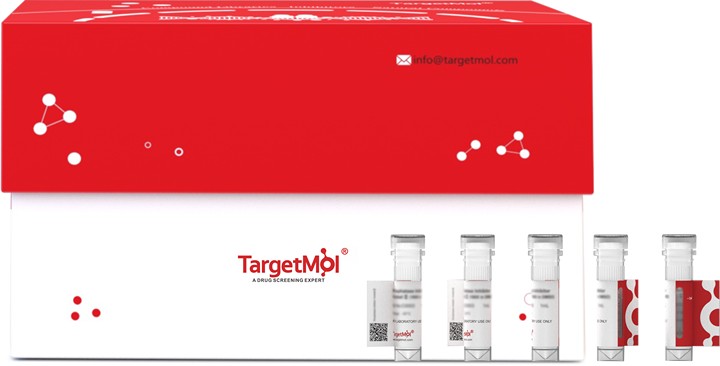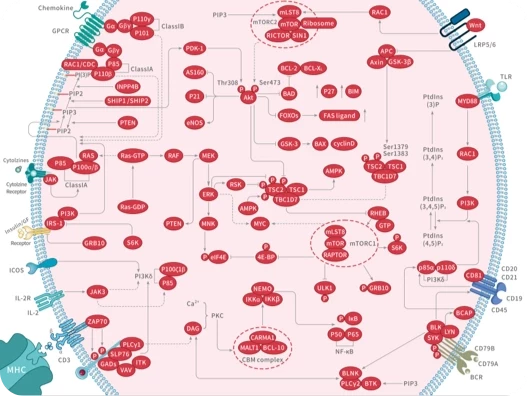 您的购物车当前为空
您的购物车当前为空
ADPRH Protein, Human, Recombinant (His)
一键复制产品信息Cholera toxin (CT) produced by Vibrio cholerae causes the devastating diarrhea of cholera by catalyzing the ADP-ribosylation of the alpha subunit of the intestinal Gs protein (Gsalpha), leading to characteristic water and electrolyte losses. Mammalian cells contain ADP-ribosyltransferases similar to CT and an ADP-ribosyl(arginine)protein hydrolase (ADPRH), which cleaves the ADP-ribose-(arginine)protein bond, regenerating native protein and completing an ADP-ribosylation cycle. CT-catalyzed ADP-ribosylation of cell proteins can be counteracted by ADPRH, which could function as a modifier gene in disease. Further, our study demonstrates that enzymatic cross talk exists between bacterial toxin ADP-ribosyltransferases and host ADP-ribosylation cycles. In disease, toxin-catalyzed ADP-ribosylation overwhelms this potential host defense system, resulting in persistence of ADP-ribosylation and intoxication of the cell. Mono-ADP-ribosylation is a reversible modification of proteins with NAD:arginine ADP-ribosyltransferases and ADP-ribosylarginine hydrolases (ADPRH) catalyzing the opposing arms of an ADP-ribosylation cycle. The ADPRH cDNA had been cloned from human, rat, and mouse tissues and high levels of mRNA were found in brain, spleen, and testis. Human ADP-ribosylhydrolase 1 (hARH1, ADPRH) cleaves the glycosidic bond of ADP-ribose attached to an Arg residue of a protein.

ADPRH Protein, Human, Recombinant (His)
一键复制产品信息| 规格 | 价格 | 库存 | 数量 |
|---|---|---|---|
| 5 μg | ¥ 493 | 6-8日内发货 | |
| 10 μg | ¥ 790 | 6-8日内发货 | |
| 20 μg | ¥ 1,330 | 5日内发货 | |
| 50 μg | ¥ 2,580 | 5日内发货 | |
| 100 μg | ¥ 5,170 | 5日内发货 |
产品信息
| 生物活性 | Activity testing is in progress. It is theoretically active, but we cannot guarantee it. If you require protein activity, we recommend choosing the eukaryotic expression version first. |
| 产品描述 | Cholera toxin (CT) produced by Vibrio cholerae causes the devastating diarrhea of cholera by catalyzing the ADP-ribosylation of the alpha subunit of the intestinal Gs protein (Gsalpha), leading to characteristic water and electrolyte losses. Mammalian cells contain ADP-ribosyltransferases similar to CT and an ADP-ribosyl(arginine)protein hydrolase (ADPRH), which cleaves the ADP-ribose-(arginine)protein bond, regenerating native protein and completing an ADP-ribosylation cycle. CT-catalyzed ADP-ribosylation of cell proteins can be counteracted by ADPRH, which could function as a modifier gene in disease. Further, our study demonstrates that enzymatic cross talk exists between bacterial toxin ADP-ribosyltransferases and host ADP-ribosylation cycles. In disease, toxin-catalyzed ADP-ribosylation overwhelms this potential host defense system, resulting in persistence of ADP-ribosylation and intoxication of the cell. Mono-ADP-ribosylation is a reversible modification of proteins with NAD:arginine ADP-ribosyltransferases and ADP-ribosylarginine hydrolases (ADPRH) catalyzing the opposing arms of an ADP-ribosylation cycle. The ADPRH cDNA had been cloned from human, rat, and mouse tissues and high levels of mRNA were found in brain, spleen, and testis. Human ADP-ribosylhydrolase 1 (hARH1, ADPRH) cleaves the glycosidic bond of ADP-ribose attached to an Arg residue of a protein. |
| 种属 | Human |
| 表达系统 | E. coli |
| 标签 | N-His |
| 蛋白编号 | P54922 |
| 别名 | ARH1,ADP-ribosylarginine hydrolase |
| 蛋白构建 | A DNA sequence encoding the human ADPRH (NP_001116.1) (Met1-Leu351) was expressed with a polyhistidine tag at the N-terminus. Predicted N terminal: His |
| 蛋白纯度 | > 90 % as determined by SDS-PAGE |
| 分子量 | 41.7 kDa (predicted); 41 kDa (reducing conditions) |
| 内毒素 | Please contact us for more information. |
| 蛋白性状 | Lyophilized powder |
| 缓冲液 | Lyophilized from a solution filtered through a 0.22 μm filter, containing PBS, pH 7.4. Typically, a mixture containing 5% to 8% trehalose, mannitol, and 0.01% Tween 80 is incorporated as a protective agent before lyophilization. |
| 复溶方法 | A Certificate of Analysis (CoA) containing reconstitution instructions is included with the products. Please refer to the CoA for detailed information. |
| 存储 | It is recommended to store recombinant proteins at -20°C to -80°C for future use. Lyophilized powders can be stably stored for over 12 months, while liquid products can be stored for 6-12 months at -80°C. For reconstituted protein solutions, the solution can be stored at -20°C to -80°C for at least 3 months. Please avoid multiple freeze-thaw cycles and store products in aliquots. |
| 运输方式 | In general, Lyophilized powders are shipping with blue ice. |
| 研究背景 | Cholera toxin (CT) produced by Vibrio cholerae causes the devastating diarrhea of cholera by catalyzing the ADP-ribosylation of the alpha subunit of the intestinal Gs protein (Gsalpha), leading to characteristic water and electrolyte losses. Mammalian cells contain ADP-ribosyltransferases similar to CT and an ADP-ribosyl(arginine)protein hydrolase (ADPRH), which cleaves the ADP-ribose-(arginine)protein bond, regenerating native protein and completing an ADP-ribosylation cycle. CT-catalyzed ADP-ribosylation of cell proteins can be counteracted by ADPRH, which could function as a modifier gene in disease. Further, our study demonstrates that enzymatic cross talk exists between bacterial toxin ADP-ribosyltransferases and host ADP-ribosylation cycles. In disease, toxin-catalyzed ADP-ribosylation overwhelms this potential host defense system, resulting in persistence of ADP-ribosylation and intoxication of the cell. Mono-ADP-ribosylation is a reversible modification of proteins with NAD:arginine ADP-ribosyltransferases and ADP-ribosylarginine hydrolases (ADPRH) catalyzing the opposing arms of an ADP-ribosylation cycle. The ADPRH cDNA had been cloned from human, rat, and mouse tissues and high levels of mRNA were found in brain, spleen, and testis. Human ADP-ribosylhydrolase 1 (hARH1, ADPRH) cleaves the glycosidic bond of ADP-ribose attached to an Arg residue of a protein. |









































 |
|